Reading Japanese Food Labels: Kanji Cheatsheet
Savvy's Guide To Stress-Free Grocery Shopping
A cheat sheet of all you need to know for efficient and safe grocery shopping in Japan.
Have you ever felt like Alice in Wonderland when visiting a Japanese supermarket? Or found yourself spending more time than you have staring at a package, trying to figure out what the heck you’re looking at? Been there, done that. Don’t feel embarrassed—we’ve all made at least one prayer to the god of labels asking for some secret knowledge. For those of you who shop regularly and are regular label readers—either because of dietary restrictions, allergies, or things you want to avoid for your health—but find yourselves lost in Japan, here’s a quick guide to navigating the supermarket and reading Japanese food nutrition labels and ingredients.
Navigating The Japanese Supermarket
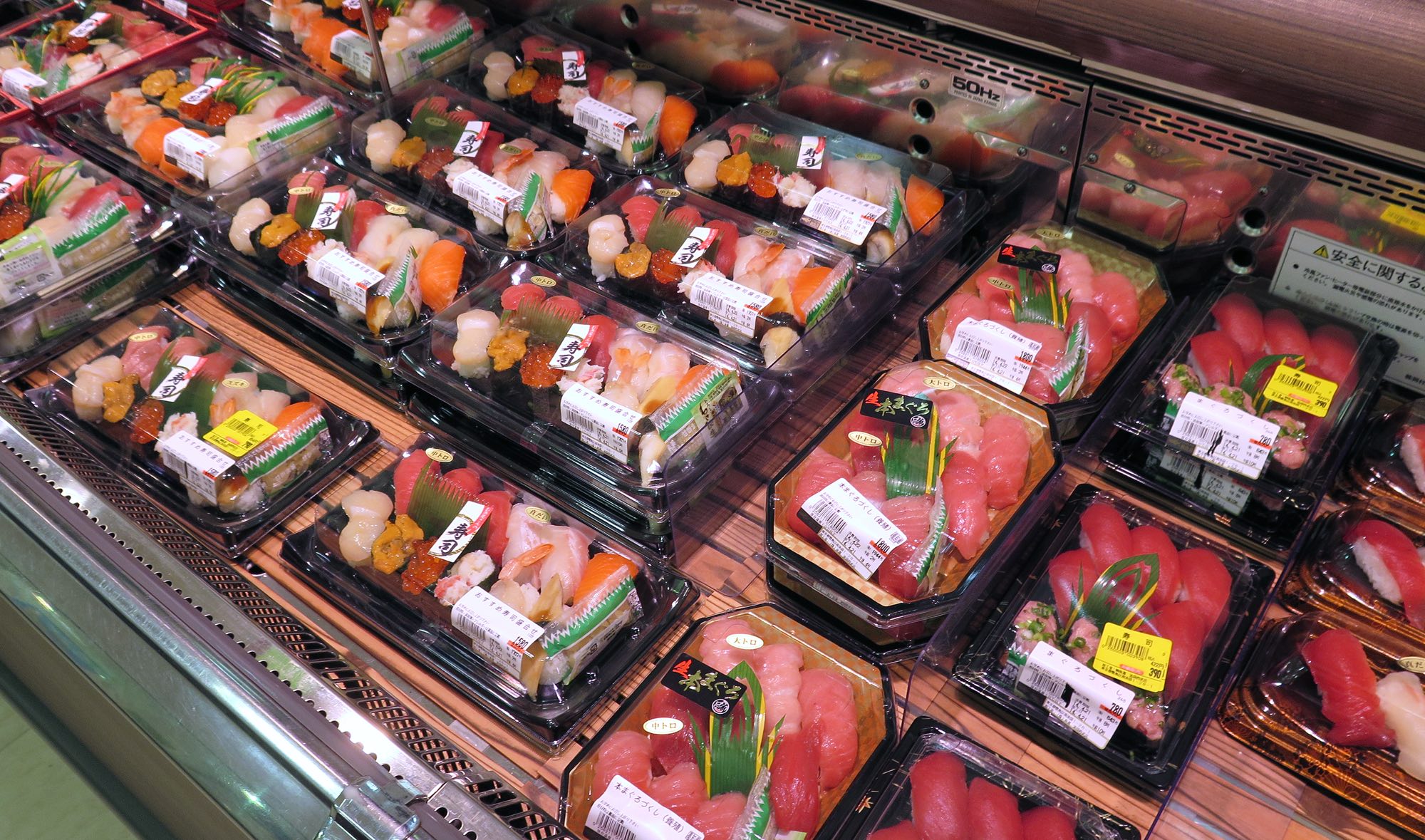 © Photo by iStock:BLUEXHAND
© Photo by iStock:BLUEXHANDMost Japanese supermarkets are not difficult to navigate as they are more or less the same as in other countries. At times, though, it’s easy to get lost when searching for the perfect soba or ingredients for that home-inspired gravy sauce. You can orient yourself by looking at the product category sections, usually separated by green banners hanging from the ceiling. Below are the names of the most common ones.
| Japanese | Rōmaji | English |
| 青果 | seika | Fruit & vegetables |
| 鮮魚 | sengyo | Raw fish |
| 食肉 | shokuniku | Meat |
| 加工肉 | kakoniku | Processed meat or in other words sausages, ham and other goodies |
| 生肉 | namaniku | Everything from chicken, pork and beef to ground meat and the like |
| 菓子 | kashi | Snacks and cookies |
| 麺類 | menrui | Instant noodles, soba, udon |
| デリカ or 惣菜 | derika or sozai | Appetizers, ready salads, fried bites, finger food and ready meals |
| パン | pan | Bread |
| 加工食品 | kakoshokuhin | Canned and packaged food |
| 米 | kome | Rice |
| 冷凍食品 | reitoshokuhin | Frosted foods |
| 漬物 | tsukemono | Pickles |
| 和日配 | wanippai | Japanese bits and bites, including tofu, oden, salads |
| 洋日配 | yonippai | Dairy products: milk, ice cream, yogurt, cheese, butter |
| ドライ飲料 | dorai inryo | Juice, canned coffee, mineral water |
Product Labels
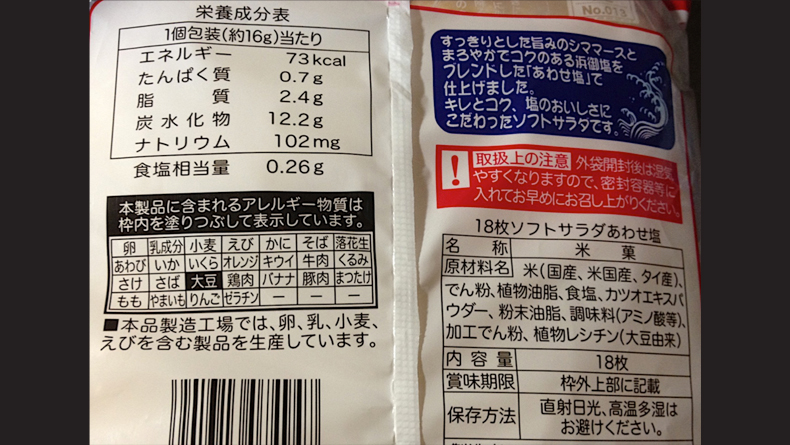
Now that you’ve found the proper grocery category, let’s look at the product labels! Above is the back of a bag of senbei (rice crackers) carrying a standard Japanese nutrition label.
- Top left: we see the nutritional information (栄養成分表, eiyou seibun you), which contains all the basic nutrition facts about the product, such as grams of carbohydrates, protein and fat.
- Middle left: above the bar code, we see a list of common allergens, highlighted in black for these particular rice crackers.
- Bottom right: we see a box with various information, including the ingredient list.
Here are some of the common terms you can look out for when reading Japanese food labels:
Nutritional Information
| Japanese | Rōmaji | English |
| エネルギー/熱量 | enerugi/netsuryoui | Calories |
| たんぱく質 | tanpakushitsu | Proteins |
| 脂質 | shishitsu | Fat |
| 炭水化物 | tansuikabutsu | Carbohydrates |
| ナトリウム | natoriumu | Sodium |
| 糖質 | toshitsu | Carbohydrates/Glucides |
| 食物繊維 | shokumotsu sen-i | Food fiber |
| カルシウム | karushium | Calcium |
| 食塩相当量 | shokuen soto ryo | Sodium chloride amount |
Ingredients & Product Infomation
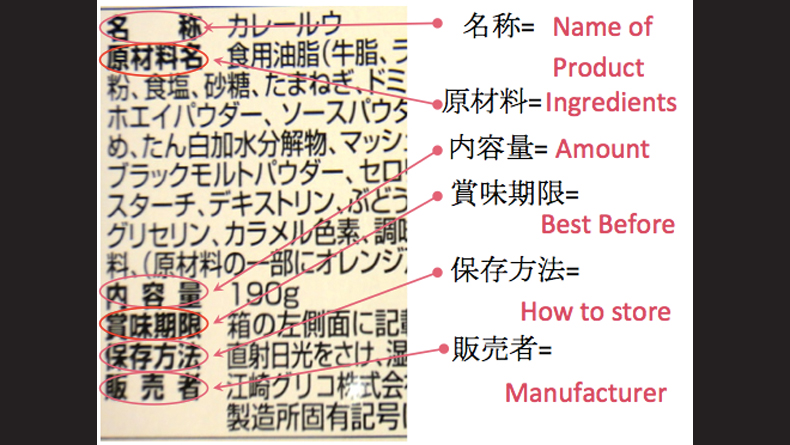
Food Restrictions & Allergens
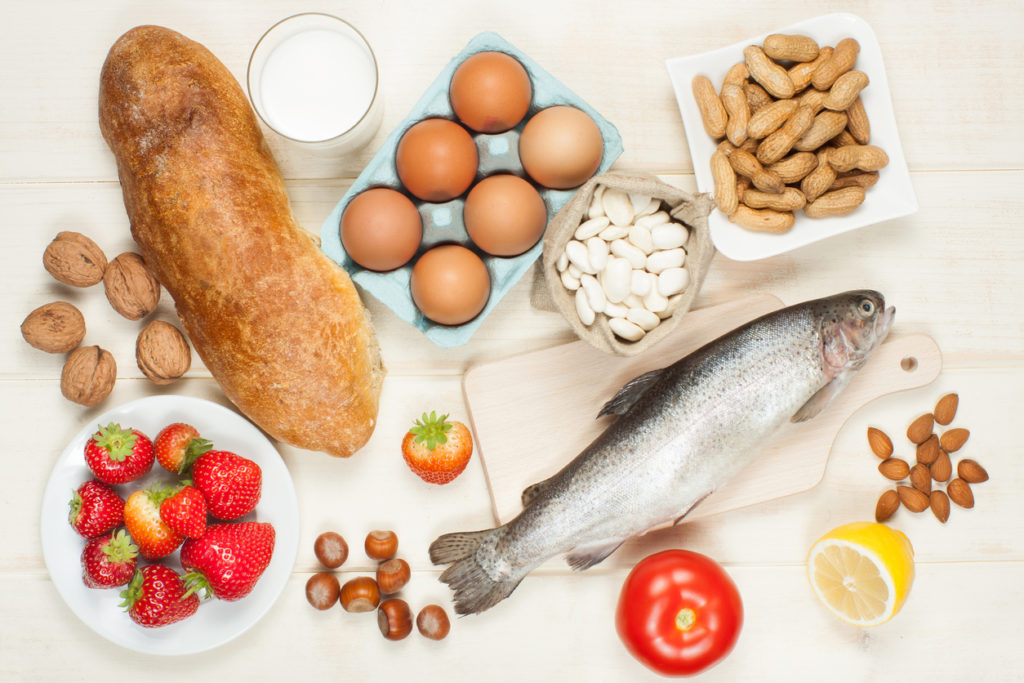 © Photo by iStock: piotr_malczyk
© Photo by iStock: piotr_malczykOkay, you have the right product in your hands—it looks familiar—but you’re not quite sure if it contains potential ingredients you may be allergic to or simply want to avoid. The list below contains useful phrases for food restrictions and ingredients to avoid if you have allergies or restrictions—or refer to this guide if you need more detailed terms for natural foods and dietary restrictions—or this one for more about food allergies in Japan.
Nutritional Restrictions
| Japanese | Rōmaji | English |
| 糖質オフ/低糖質 | toshitsu-ofu/teitoshitsu | Low sugar |
| カロリーオフ/低カロリー | karorii-ofu/teikarorii | Low calorie |
| 脂質オフ/低脂質 | shishitu-ofu/teishishitsu | Low fat |
| 塩分オフ | enbun-ofu | Low salt |
| カロリーゼロ | karorii-zero | Calorie free |
| 脂質ゼロ | shishitsu-zero | Fat free |
| 糖質ゼロ/無糖 | toushitsu-zero/muto | Sugar free |
Allergens
| Japanese | Rōmaji | English |
| 卵/玉子/たまご | tamago | Egg |
| 牛乳/乳 | gyuunyuu | Milk/Dairy products |
| 小麦(粉) | komugi(ko) | Wheat/Flour |
| 落花生/ピーナッツ | rakkasei/pinattsu | Peanut |
| 蕎麦/ソバ | soba | Buckwheat |
| 海老/エビ | ebi | Shrimp |
| 蟹/カニ | kani | Crab |
| あわび/アワビ | awabi | Abalone |
| いか/イカ | ika | Cuttlefish |
| いくら/イクラ | ikura | Salmon row |
| 鮭/サケ/しゃけ/シャケ/サーモン | sake/shake/saamon | Salmon |
| 鯖/サバ | saba | Mackerel |
| 牛/牛肉/ビーフ | ushi/gyu-niku/biifu | Beef |
| 豚/豚肉/ポーク | buta/buta-niku/pooku | Pork |
| 鶏/鶏肉/チキン | tori/tori-niku/chikin | Chicken |
| ゼラチン | zerachin | Gelatin |
| 大豆/ダイズ | daizu | Soybean |
| キウイ(フルーツ) | ki-u-i(furuutsu) | Kiwi fruit |
| 胡桃/クルミ | kurumi | Walnut |
| バナナ | banana | Banana |
Price Labels
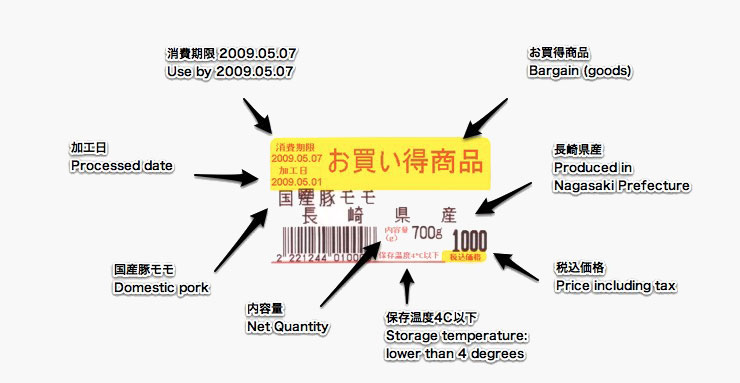
Price labels usually contain information on when the product was manufactured, the best-before date, net quantity, production area, and, uh, the price. The above is a prime example. If you see anything written in yellow and red, it’s usually a special promotion or a discounted product.
And if you’re cautious about where your food comes from, pay attention to the following words:
| Japanese | Rōmaji | English |
| 原産地/原産国 | gensanchi/gensan koku | Produced in/Made in |
| 日本/国産 | nihon/koku san | Made in Japan |
| 中国産 | chuugoku san | Made in China |
| 米国/アメリカ産 | beikoku/amerika san | Made in America |
| オーストラリア産 | oosutoraria san | Made in Australia |
| カナダ産 | kanada san | Made in Canada |
| ニュージーランド産 | nyuu jiirando san | Made in New Zealand |
| タイ産 | tai san | Made in Thailand |
With new products and imports increasing daily, this is by no means a complete guide, but we hope it will make your shopping slightly more efficient and less stressful. If we’ve missed any of your favorite products or important ingredients, leave us a comment.
We also welcome your funny stories about reading Japanese food labels incorrectly—we certainly have our fair share, too!
















Leave a Reply